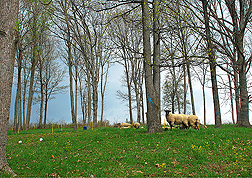This page has been archived and is being provided for reference purposes only. The page is no longer being updated, and therefore, links on the page may be invalid.
| Read the magazine story to find out more. |
|
|
|
|
Tannins' Surprising Benefits for Soils, Forests and Farms
By Don Comis
November 17, 2010
The tannins that help make good red wine and bright fall colors also may help make good soil and healthy livestock, according to U.S. Department of Agriculture (USDA) researchers.
Chemist Javier Gonzalez and soil scientist Jonathan Halvorson, both at the Agricultural Research Service (ARS) Appalachian Farming Systems Research Center (AFSRC) in Beaver, W.Va., are leading a tannin research project that's now in its fourth year. Results from the studies by Gonzalez, Halvorson and their colleagues indicate tannins are important components of agroecosystems that can also affect production and environmental quality. ARS is USDA's principal intramural scientific research agency.
The scientists will use their results to develop recommendations for using tannins to manage soils and silvopastures, where livestock graze in thinned forests.
Tannins and other phenolic compounds are common in many plants. These compounds, believed to enter soil from plant roots and decaying leaves, may also be part of "teas" formed as rain and snowmelt run down tree bark and drip off the leaves.
The work is being done jointly with chemist Ann Hagerman's renowned tannin laboratory at Miami University in Oxford, Ohio. The two labs are combining their capabilities to identify important features of tannins that determine soil interactions.
Results to date show the rate and amount of binding to soil varied from one tannin to another. The scientists found that the binding quality of tannins also can be used to immobilize metals such as aluminum, lessening the metals' toxic effects on root growth. Tannin-related phenolics can also free up nutrients such as calcium for crop use.
The scientists are learning more about how forest soil microbes metabolize tannins, leading to a better understanding of the varied ecological functions performed by tannins. The AFSRC scientists also are studying the nutritional and deworming potential of tannin-containing forages for goats.
Read more about this research in the November/December 2010 issue of Agricultural Research magazine.
This research was published in Physiologia Plantarum, and in Soil Biology & Biochemistry.

